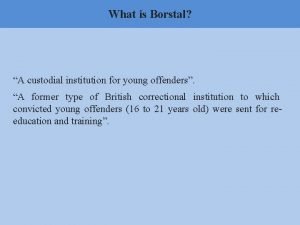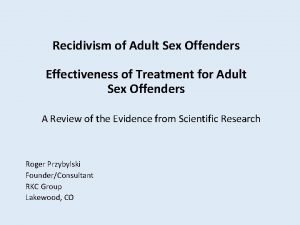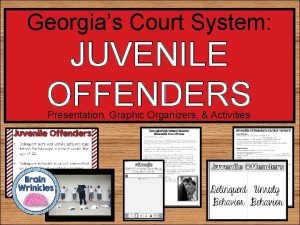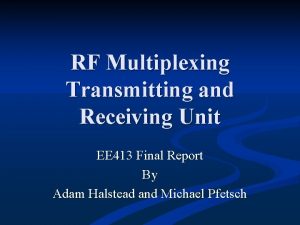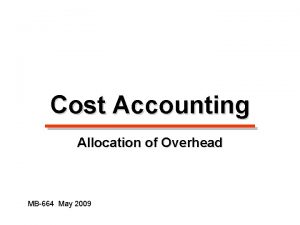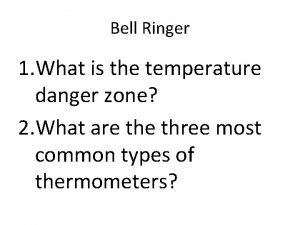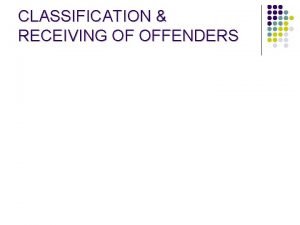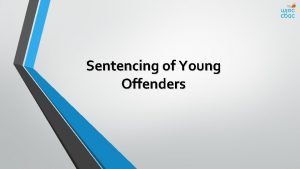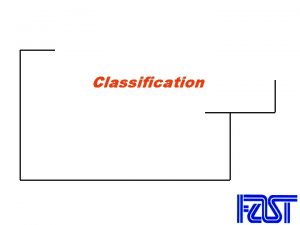CLASSIFICATION RECEIVING OF OFFENDERS Goal l To provide
















































- Slides: 48

CLASSIFICATION & RECEIVING OF OFFENDERS

Goal l To provide a working knowledge of inmate classification and receiving

Performance Objectives l Upon completion the student will be able to pass a written test at 80% on the following l l A. Define “classification” B. Discus categories of inmates l l l 1. Male and female 2. Juveniles 3. Administrative segregation 4. Protective custody Medical/handicap and mental classification

Performance Objectives - Cont l C. Identify security classifications of inmates to include: l l 1. Crimes committed 2. Known or stated affiliations 3. Escape risk 4. Violent or aggressive

Learning Objectives l What is objective classification? l What is the purpose of objective classification? l Why is objective classification important?

CLASSIFICATION & RECEIVING OF OFFENDERS CLASSIFICATION DEFINED “A systematic arrangement in groups or categories according to established criteria. ” -Merriam-Webster

OBJECTIVE CLASSIFICATION USE OF CLASSIFICATION RISK ASSESSMENTS WITHIN THE NEVADA DEPARTMENT OF CORRECTIONS

Nevada Revised Statutes l Per 209. 131 the Director’s duties include: l l Receive, retain and release, in accordance with the law, offenders sentenced to imprisonment in the state prison. Be responsible for the supervision, custody, treatment, care, security and discipline of all offenders under his or her jurisdiction. Establish regulations with the approval of the Board and enforce all laws governing the administration of the Department and the custody, care and training of offenders. Take proper measures to protect the health and safety of the staff and offenders in the institutions and facilities of the Department.

Regulations l A big part of how the Director complies with these requirements as it pertains to safety of the public, as well as staff and inmates, is by the regulations governing the classification of inmates. The 500 series of the Administrative Regulations pertain to the classification and management of inmates. Some of the main AR’s which pertain to objective classification are: 503, 504, 521, 523 & 543

What is Classification l Classification is the categorization process used by NDOC to determine where an inmate belongs within the prison system l Computed Custody: Custody level dictated by a numerical score (Objective Classification) l Automatically calculated by NOTIS based upon the Risk Factor Score (RFS) or when a specific exclusion is entered

What is Classification? l l Recommended Custody: Custody level being recommended by the classification committee if other than the computed custody. Approved Custody: Custody level approved by a CCSIII or Offender Management Division (OMD) l Initial Classification, custody reduction to MIN or CT, transfer between institutions/facilities or other jurisdictions and classification requiring an override must be reviewed and approved by OMD

Purpose of classification l The purpose of classification is to: l l To determine if an inmate’s case factors warrant a change in custody or housing. Protect staff, inmates and the community Provide a system of positive and negative consequences for behavior Provide an criteria for the determination of placement l Inmates should receive reasonable notice of scheduled classification; 24 hours before the start of the classification hearing. l Inmates should be present unless circumstances dictate otherwise.

Classification Hearings Classification Committee should use: l Institutional files, NOTIS/OSM information and information presented by the inmate or other interested parties

Classification Hearings Classification Committee should: l Determine if the inmate’s case factors warrant a change in custody or housing by reviewing the objective classification instrument l Inmate should make a personal appearance before the committee and present their point of view or submit documents bearing on the proposed committee action

Classification Hearings l When are they used? l Employment l Due Process Hearings l To dispute STG status l Intake Classifications l Regular (6 month) reviews l Anytime deemed necessary or appropriate

Why is classification important? l Classification has the potential to save lives when done correctly l Classification has the potential to cost lives when done incorrectly

Types of Classification l l Initial Classification Periodic Reclassification l Change Classification

Initial Classification Completed upon entrance into NDOC custody l All case factors are entered into the NOTIS and the OSM system such as: l l l l l Crime (Instant offense) Sentence structure Gang affiliation Sex Offender status Medical, Dental & Mental Health Concerns Educational level/testing Previous criminal history Any additional relevant case factors

Required Documentation l Judgment of Conviction – New Commit Inmate. l Retake Warrant – Parole Violator.

Periodic Reclassification l Completed a minimum of every six months l Completed when inmate becomes eligible for change in status

Initial Reception l Northern Nevada l l l Northern Nevada Correctional Center Lovelock Correctional Center (Juveniles) Southern Nevada l l High Desert State Prison Florence Mc. Clure Correctional Center (Females)

Reception Classification l q q Completed when inmate arrives at a new institution Sometimes inmates can be reviewed and approved up to weeks or even months prior to being able to be scheduled and transferred. Transportation Coordinators will review to make sure no barriers before scheduling, such as separatees, court dates, PB hearing, etc. Staff at an institution/facility will have a better understanding of their yard/population and, after reviewing the file and speaking with the inmate, may need to make a change to what had previously been approved.

AR 521 Custody Categories & Criteria l Maximum Custody l l Ex: Lock-up status at Ely State Prison Close Custody l l Ex: Protective Segregation at Lovelock Correctional Center Ex: General population at Ely State Prison

AR 521 Custody Categories & Criteria l Medium Custody l l Minimum Custody l l Ex: General Population at Southern Desert Correctional Center Ex: Three Lakes Valley Conservation Camp Community Trustee l l Ex: Residential Confinement Casa Grande Transitional Housing

Maximum Custody: Characteristics Single cell l Direct supervision l Limited time outside cell l Unclothed searches on exiting and returning to housing unit l Restrained when moved inside or outside institution l

Maximum Custody includes: l Segregation at Ely State Prison l Inmates designated as High Risk Potential (HRP) l Inmates on Death Row (Sentenced to Death)

Close Custody: Characteristics l Double or single cells in protective segregation l Single cells for administrative or disciplinary segregation l Direct supervision

Close Custody: Characteristics l Separate housing from general population l May be restrained during internal movement l Will be restrained during external movement

Close Custody: Criteria l Assignment to specialized housing areas of medium security institutions designated for protective segregation, disciplinary detention, or disruptive group management l Close custody is the custody designation for the general population of a maximum security institution (ex: ESP)

Close Custody: Criteria Includes l Inmates with a history of violence, escape or conspiracy to escape l Inmates whose conduct indicates their behavior cannot be controlled at lower custody levels l Evaluation and control of inmates for not less than one year with sentence of 20 years or more or for 2 years for each Life Without Parole sentence.

Medium Custody: Characteristics l General population of medium security institution l Participation in work and program activities within the perimeter of the institution

Medium Custody: Characteristics l Random searches l Movement without restraints inside institution l Movement with restraints outside institution

NRS 209. 481 1. 209. 481 lists the criteria for which the Director shall not assign any prisoner to an institution or facility of minimum custody, and they are: 1. Except for DUI offenses, not eligible for parole or release from prison within a reasonable period 2. Has recently committed a serious infraction of the rules of an institution or facility of the Department 3. Has not performed the duties assigned to him or her in a faithful and orderly manner 4. Has ever been convicted of a sexual offense that is punishable as a felony 5. Has, within the immediately preceding year, been convicted of any crime involving the use or threatened use of force or violence against a victim that is punishable as a felony 6. Has attempted to escape or has escaped from an institution of the Department.

Minimum Custody: Characteristics l l l Assignment to facilities without secure perimeters Double cell or dormitory housing Intermittent supervision Random searches Transportation without restraints Work supervision by state employee (non NDOC staff trained to supervise inmates such as Nevada Division of Forestry)

Minimum Custody: Criteria l Total Risk Factor Score (RFS) of 13 points or less l Be within 36 months of probable release from NDOC custody l Have performed assigned duties in a faithful or orderly manner

Minimum Custody Criteria Disqualifying Criteria l RFS of 10 points or more in Section “A” of the reclassification instrument l Committed a serious violent major infraction of AR 707 within the immediately preceding 12 months l Committed any major or work infraction of AR 707 within the immediately preceding 6 months

Minimum Custody Criteria Disqualifying Criteria l Having ever been convicted of a sexual offense that is punishable as a felony l Two or more charges for sexual offenses arising from separate incidents. Requires a “Due Process” hearing. l Having ever been convicted of a felony crime for any offense involving the intended death of any victim

Minimum Custody Criteria Disqualifying Criteria l Been convicted of using or threatened use of force against a victim that is punishable as a felony immediately preceding 12 months l Escape or attempted escape from an NDOC institution or community supervised program

Minimum Custody Criteria Disqualifying Criteria l l Ever convicted of a felony for the escape or attempted escape from any Medium custody prison or jail l Minimum Custody: not within immediately preceding 120 months Have a current felony detainer lodged against them

Minimum Custody Criteria Disqualifying Criteria l Have a death or life without the possibility of parole sentence l Require protective segregation l Serving a disciplinary segregation or disciplinary detention sanction

Discretionary Exclusions for Minimum Custody l l l l Youthful Inmate Medical, Dental or Mental health concerns Other agency escape charges Disciplinary Record Violent Offender Concurrent or consecutive non-NDOC sentence(s) Other relevant factors

Exceptions to Criteria Determining Minimum Custody l Inmates serving DUI sentences under NRS 484 C. 400, 484 C. 410, 484 C. 430, 488. 425 and 488. 427, who have no non-DUI offenses as part of their sentence restructure are exempt from the 36 months to probable release criteria l Inmates with a RFS of 14 or more points can be considered for minimum custody on a case by case basis l Require an override from the OMD Administrator prior to approval

Considerations: Evaluating Inmates for Minimum Custody l Should review and/or reclassify a minimum custody inmate after a disciplinary finding for a serious infraction or an infraction that raises the inmate’s RFS to 14 points or more l If determination is NOT to increase the inmate’s custody level and no classification is done, verbal approval should be obtained from the OMA and case noted.

Considerations: Evaluating Inmates for Minimum Custody l If the determination is to increase the inmate’s custody level, staff must immediately treat the inmate at the recommended custody level and reclassify accordingly

Community Trustee Custody Characteristics Include: l l l May be assigned to facilities without perimeters or towers May be single or double occupancy cells or dormitory type housing. May be housed within NDOC or may be under residential confinement Staff supervision may be intermittent and on the job site Subject to random searches and or for cause Participation in work and/or education activities outside the perimeter of the facility

Community Trustee Criteria Must be eligible for minimum custody per AR 521. 04 l Must have a RFS of 11 or less l Inmate cannot have ever been convicted of any escape l Cannot have ever been convicted of any sex offense l

Community Trustee: Criteria No felony convictions involving violence/threat of violence within the last 3 years l Cannot be currently serving time for a violent crime on the same booking number l

Conclusion l Classification is a critical part of maintaining the safety and security of staff, inmates and the community l Questions
 A custodial institution for young offenders.
A custodial institution for young offenders. For adult sex
For adult sex Young offenders act
Young offenders act Cognitive behavioral therapy for sex offenders
Cognitive behavioral therapy for sex offenders According to choice theorists, offenders
According to choice theorists, offenders Juvenile delinquency graphic organizer
Juvenile delinquency graphic organizer Youthful offenders act 1854
Youthful offenders act 1854 Modern evolutionary classification
Modern evolutionary classification It is a very shallow skillet with very short sloping sides
It is a very shallow skillet with very short sloping sides Quality control
Quality control Gmail not receiving emails
Gmail not receiving emails Suppliers' inspection reports should be based on
Suppliers' inspection reports should be based on Direct putaway
Direct putaway Procedures in receiving and storing tools and materials
Procedures in receiving and storing tools and materials An institution for receiving, keeping and lending money
An institution for receiving, keeping and lending money Receiving god's gifts life in the spirit seminar
Receiving god's gifts life in the spirit seminar What is love tank
What is love tank Love language meaning
Love language meaning This section discusses
This section discusses Purchasing and receiving
Purchasing and receiving The process of giving and receiving information
The process of giving and receiving information Unlv mileage reimbursement
Unlv mileage reimbursement Servsafe food storage diagram
Servsafe food storage diagram Receiving visitors in the office conversation
Receiving visitors in the office conversation Receiving in food flow
Receiving in food flow Giving and receiving feedback by phil rich
Giving and receiving feedback by phil rich The flow of food purchasing receiving and storage
The flow of food purchasing receiving and storage Christ with the sick around him, receiving the children
Christ with the sick around him, receiving the children You are receiving this email because
You are receiving this email because You are receiving this email because
You are receiving this email because You are receiving this email because
You are receiving this email because Lemon trees receiving the most water
Lemon trees receiving the most water Central receiving hospital
Central receiving hospital Sending and receiving signals are special constructs of
Sending and receiving signals are special constructs of Complex transmitting and receiving unit
Complex transmitting and receiving unit Risk of blood transfusion
Risk of blood transfusion Uncc receiving and stores
Uncc receiving and stores Example of affective objectives
Example of affective objectives Low order thinking skills
Low order thinking skills An ordering and receiving materials cost pool
An ordering and receiving materials cost pool A process of receiving selecting organizing
A process of receiving selecting organizing Receiving temperature of fresh poultry
Receiving temperature of fresh poultry Receiving chambers of the heart
Receiving chambers of the heart Lazy learner and eager learner
Lazy learner and eager learner Simple and manifold classification
Simple and manifold classification Traditional classification vs modern classification
Traditional classification vs modern classification The united states ought to provide a universal basic income
The united states ought to provide a universal basic income Provide valet services to guests
Provide valet services to guests Room service trolley set up for breakfast
Room service trolley set up for breakfast
